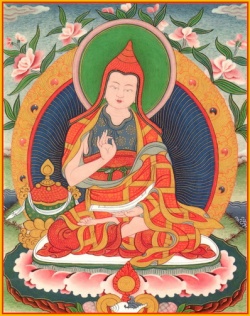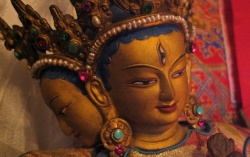Mandala – a portrayal of truth and the celebration of life
In the Newar community, New Year (Nhudan) is celebrated by worshiping oneself. Additionally, different exhibitions are held in various Buddhist monasteries of Patan on this day. A young artists’ group, the Vajra Group, had exhibited the mandala of Vasundharā at Hakha Bahal in Patan on the auspicious day of the Nepal Era 1133 NS.
Mandala is a Pāli and Sanskrit word that literally means “circle” or “round”. The Sun, the Moon and the Earth are round, thus they are called Surya Mandala, Chandra Mandala and Bhu Mandala respectively. At certain points in history, geographically, Nepal might have been round, so it is also called Nepal Mandala. The term Mandala as a round circle first appears in the Theravāda, the Buddhist Pāli literature Dighanikāya. The Atānātiya Sutra of Dighanikāya mentions the ‘Surya Mandala or Ādiccha Mandala’. A Mandala has artistic, religious and meditative values in Buddhism. A Mandala represents the entire universe in which Mount Meru is depicted at the centre and surrounded by the continents, oceans and mountains. “A Mandala Offering” in Mahāyāna Buddhism is a symbolic offering of the entire universe to the Buddha and the Bodhisattvas.
A Mandala is a diagram or map of a sacred and pure Buddha realm or an abode of fully realized beings or deities. It is two or three-dimensional geometric composition which forms a square with four gates within a circle. The concern deity is placed in the centre of the Mandala and it is recognized according to the placement of central deity i.e. if the Vasundharā is placed at the centre, it is called the Vasundharā Mandala.
According to Buddhist Tantric literature like the Hevajra Tantra and Guhyasamāja Tantra, the term Mandala is composed of two words ‘ Manda’ and ‘la’. Manda bears the meaning ‘the essence’ (sāra in Sanskrit) and ‘la’ means ‘to bring or to accept’. Newari people used the word ‘Mandah’ instead of Mandala. The Hevajra Tantra commentary literature explains ‘sāra’ or essence, as the knowledge of Great Happiness (Mahāsukha). But according to Guhyasamāj Tantra commentary, a Mandala is the knowledge of conventional and absolute truth i. e. the knowledge of Sambriti and Paramārth Satya. Hence, the Mandala represents the knowledge of great happiness and the knowledge of truth or reality.
Mahāyāna and Vajrayāna Buddhism developed Mandala into the art of sand painting. In Nepal, Tibetan and Bhutanese sand Mandalas are very popular. Nepali Vajracharyas use sand Mandala in their Buddhist ritual practices. They draw a Mandala with soft stone white powder called “Potāyachooun”. They also use cinnabar (sindur) and other powder colors. They usually perform the Guru Mandala Pujā (‘Guru Maṇḍa Danegu’ in Newari) before performing other pujā and vratas.
Mandala worship seems to be very ancient in Nepal. Not only Buddhists but all Newari people worship the Mandala in their New-Year festival, which usually falls in October. They perform the “Mha-puja” (self worshipping) by making a sand Mandala using potāyachooun. It is called “Dhalan danegu” in Newari. In the 1990s, the Nepal Bhāṣā Mankā Khalah organized a sand Mandala making contest, “Mandala Kāsā” in Patan, on the occasion of New Years, which has since been continuously organized by local Patan organizations. Similarly, sand Mandalas are exhibited in various monasteries and temples of Patan to observe the New Year festival. Usually young artists are interested in this creative work.
On this year’s New Year 1133 NS, Mandala exhibitions were held at various places of Patan, such as Vajradhātu Mandala at Mahābodhi Temple, Mahābauddha, Okubahāl; sandpainting of Vasundhara at Hakhabahāl; sand Mandalas at Raksesvara Mahavihār, Pulchoka and Nyādha Tole, Patan; mosaic type images of Goddess Laxmi made of egg shells at Nagbahāl, Patan; and at Basantapur, Kathmandu, a Mandala made of dry grains was exhibited. Among them, the Mandala image of Vasundharā at Hakhabahāl became one of the most important Mandala exhibitions of this year.
Young artists of Hakhabahāl, Patan had frequently exhibited Mandalas on the past occasions of the New Year. They first exhibited Vasundharā Mandala in their monastery on 15th November, 2001. Similarly, they made sand Mandalas of Amoghapāsa Lokesvara and Dharmadhātuvāgisvara Mandala in 2002 and 2003 respectively. This year they chose the image of Vsundharā for the Mandala exhibition because Vasundharā is a popular deity in Buddhism. The name Vasundharā is composed of two words ‘vasu’ (treasure) and ‘dharā’ (bearer), thus she is referred to as the “Bearer of Treasure”. Vasundharā is the bodhisattva of wealth and perfection (fullness) or abundance in Buddhism. She is worshiped for wealth as well as for fertility of the fields (crops) and womb (pregnancy). Vasundharā Vrata (sand Mandala worship of Vasundharā) is very popular in Newari Buddhism in the name of ‘Tilā Vrata’ or ‘Gātilā Vrata’. Vasundharā Mandala is also worshiped in the second old age initiation or ceremony (in Newari -Nikogu Budhā Budhi Janku). She is the symbolic representation or the personification of the perfection of wisdom and the Earth. She is also regarded as a witness of Siddhartha Gautam’s enlightenment. Her image is usually depicted into sculptural art and painting with i) one face two arms ii) one face six arms or iii) three faces six arms. She is usually yellow in color and holds a rice stalk (dhānya manjri) and jewel vase (ratna ghata). In the case of a six-armed image, she holds a rosary, a jewel and displays the varadamudrā (gesture of giving) in her right hands while the left hands hold a Prajñāpāramitā scripture, a rice stalk (dhānya manjri) and a full vase. Her three faces are reddish white, yellow and red in color, which symbolize creation, existence and destruction (utpatti, sthiti and bhanga) respectively. Colors also represent the images of Mahālaxmi (reddish white – right face), Vasundharā (yellow –middle face) and Kumāri (red- left face). Her image first appeared in India during the Kushana period. But in Nepal, her image was probably found from the transitional period 9th-10th century onwards. In the Licchavi period, she is represented by a full water vase (Purna kalash).
The sand Mandala image of Vasundharā this year was finely drawn by the skillful hands of the following eight young artists from the Vajra group: Bijendra Bajracharya, Sanjaya Bajracharya, Manish Bajracharya, Pradeep Bajracharya, Prabin Bajracharya, Rabi Bajracharaya, Anil Bajracharya and Jitbir Bajracharya. They first made a 12ft x 16ft platform of plywood raised a few inches above the ground. Then, they drew a line sketch of Vasundharā on normal paper and photocopied it with the required enlargement. Then they pasted it to the board and filled it with powder color of six types – blue, red, black, yellow, green and white – very carefully and skillfully with untiring effort. They learned the technique of Mandala-making from the Buddhist Monastery Training Center for Painting and Sculpture (Baudha Vihāra Citra tathā Murti Kalā Prashikṣana Kendra) at the Akṣeyasvor Mahāvihāra in Lalitpur. The Mandala-making program was organized by Ratnākara Saving and Credit Co-operative Ltd and the Ratnākar Mahāvihār Youth Group from Hakhabahāl, Patan.
Text: Mahendra Ratna Shakya, Sinchahity, Patan.



